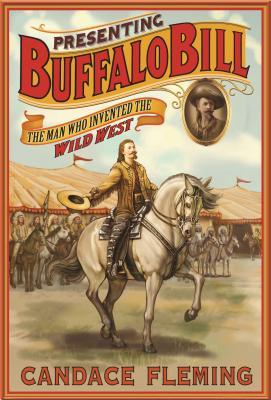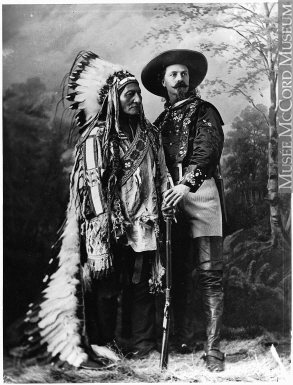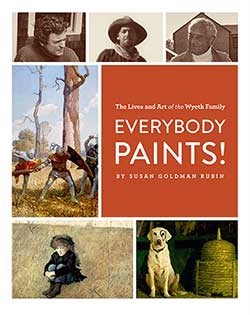 Presenting Buffalo Bill: The Man Who Invented the Wild West
Presenting Buffalo Bill: The Man Who Invented the Wild West
By Candace Fleming
A Neal Porter Book, Roaring Book Press (a division of Macmillan)
$19.99
ISBN: 9781596437630
Ages 9-12
On shelves September 20th
I’ve been thinking a lot lately about how we present history to our kids. Specifically I was thinking about picture book biographies and whether or not they’re capable of offering a nuanced perspective on a person’s complicated life. Will we ever see an honest picture book biography of Nixon, for example? In talking with a nonfiction author for children the other day, she asked me about middle grade books (books written for 9-12 year olds) and whether or not they are ever capable of featuring complicated subjects. I responded that often they’re capable of showing all kinds of sides to a person. Consider Laura Amy Schlitz’s delightful The Hero Schliemann or Candace Fleming’s The Great and Only Barnum. Great books about so-so people. And Candace Fleming… now there’s an author clearly drawn to historical characters with slippery slidey morals. Her latest book, Presenting Buffalo Bill is a splendid example of precisely that. Not quite a shyster, but by no means possessing a soul as pure as unblemished snow, had you asked me, prior to my reading this book, whether or not it was even possible to write a biography for children about him my answer would have been an unqualified nope. Somehow, Ms. Fleming has managed it. As tangled and thorny a life as ever you read, Fleming deftly shows how perceptions of the American West that persist to this day can all be traced to Buffalo Bill Cody. For good or for ill.
What do you think of when you think of the iconic American West? Cowboys and sage? American Indians and buffalo? Whatever is popping up in your head right now, if it’s a stereotypical scene, you’ve Buffalo Bill Cody to thank for it. An ornery son of a reluctant abolitionist, Bill grew up in a large family in pre-Civil War Kansas. Thanks to his father’s early death, Bill was expected to make money at a pretty young age. Before he knew it, he was trying his luck panning gold, learning the finer points of cowboy basics, and accompanying wagon trains. He served in the Civil War, met the love of his life, and gave tours to rich Easterners looking for adventure. It was in this way that Bill unwittingly found himself the subject of a popular paperback series, and from that he was able to parlay his fame into a stage show. That was just a hop, skip, and a jump to creating his Wild West Show. But was Bill a hero or a shyster? Did he exploit his Indian workers or offer them economic opportunities otherwise unavailable to them? Was he a caring man or a philanderer? The answer: Yes. And along the way he may have influenced how the world saw the United States of America itself.
 So let’s get back to that earlier question of whether or not you can feature a person with questionable ethics in a biography written for children. It really all just boils down to a question of what the point of children’s biographies is in the first place. Are they meant to inspire, or simply inform, or some kind of combination of both? In the case of unreliable Bill, the self-made man (I’m suddenly hearing Jerry Seinfeld’s voice saying to George Costanza, “You’re really made something of yourself”) Candace Fleming had to wade through loads of inaccurate data produced, in many cases, by Bill himself. To combat this problem, Ms. Fleming employs a regular interstitial segment in the book called “Panning for the Truth” in which she tries to pry some grain of truth out of the bombast. If a person loves making up the story of their own life, how do you ever know what the truth is? Yet in many ways, this is the crux of Bill’s story. He was a storyteller, and to prop himself up he had to, in a sense, prop up the country’s belief in its own mythology. As he was an embodiment of that mythology, he had a vested interest in hyping what he believed made the United States unique. Taking that same message to other countries in the world, he propagated a myth that many still believe in today. Therefore the story of Bill isn’t merely the story of one man, but of a way people think about our country. Bill was merely the vessel. The message has outlived him.
So let’s get back to that earlier question of whether or not you can feature a person with questionable ethics in a biography written for children. It really all just boils down to a question of what the point of children’s biographies is in the first place. Are they meant to inspire, or simply inform, or some kind of combination of both? In the case of unreliable Bill, the self-made man (I’m suddenly hearing Jerry Seinfeld’s voice saying to George Costanza, “You’re really made something of yourself”) Candace Fleming had to wade through loads of inaccurate data produced, in many cases, by Bill himself. To combat this problem, Ms. Fleming employs a regular interstitial segment in the book called “Panning for the Truth” in which she tries to pry some grain of truth out of the bombast. If a person loves making up the story of their own life, how do you ever know what the truth is? Yet in many ways, this is the crux of Bill’s story. He was a storyteller, and to prop himself up he had to, in a sense, prop up the country’s belief in its own mythology. As he was an embodiment of that mythology, he had a vested interest in hyping what he believed made the United States unique. Taking that same message to other countries in the world, he propagated a myth that many still believe in today. Therefore the story of Bill isn’t merely the story of one man, but of a way people think about our country. Bill was merely the vessel. The message has outlived him.
I’ve heard folks online say of the book that they can’t imagine the child who’d come in seeking a bio of Buffalo Bill. Since kids don’t like cowboys like they used to, the very existence of this book in the universe puzzles them. Well, putting aside the fact that enjoying a biography often has very little to do with the fact that you already were interested in the subject (or any nonfiction book, for that matter), let’s just pick apart precisely why a kid might get a lot out of reading about Bill. He was, as I have mentioned, a humbug. But he was also for more than that. He was a fascinating mix of good and evil. He took credit for terrible deeds but also participated in charitable acts (whether out of a sense of obligation or mere money is a question in and of itself). He no longer fits the mold of what we consider a hero to be. He also doesn’t fit the mold of a villain. So what does that leave us with? A very interesting human being and those, truth be told, make for the best biographies for kids.
 The fact that Bill is a subject of less than sterling personal qualities is not what makes this book as difficult as it is to write (though it doesn’t help). The real problem with Bill comes right down to his relationships with American Indians. How do we in the 21st century come to terms with Bill’s very white, very 19th century attitudes towards Native Americans? Fleming tackles this head on. First and foremost, she begins the book with “A Note From the Author” where she explains why she would use one term or another to describe the Native Americans in this book, ending with the sentence, “Always my intention when referring to people outside my own cultural heritage is to be respectful and accurate.” Next, she does her research. Primary sources are key, but so is work at the McCracken Research Library at the Buffalo Bill Center of the West in Cody, Wyoming. Her work was then vetted by Dr. Jeffrey Means (Enrolled Member of the Oglala Sioux Tribe), Associate Professor of History at the University of Wyoming in the field of Native American History, amongst others. I was also very taken with the parts of the book that quote Oglala scholar Vine Deloria Jr., explaining at length why Native performers worked for Buffalo Bill and what it meant for their communities.
The fact that Bill is a subject of less than sterling personal qualities is not what makes this book as difficult as it is to write (though it doesn’t help). The real problem with Bill comes right down to his relationships with American Indians. How do we in the 21st century come to terms with Bill’s very white, very 19th century attitudes towards Native Americans? Fleming tackles this head on. First and foremost, she begins the book with “A Note From the Author” where she explains why she would use one term or another to describe the Native Americans in this book, ending with the sentence, “Always my intention when referring to people outside my own cultural heritage is to be respectful and accurate.” Next, she does her research. Primary sources are key, but so is work at the McCracken Research Library at the Buffalo Bill Center of the West in Cody, Wyoming. Her work was then vetted by Dr. Jeffrey Means (Enrolled Member of the Oglala Sioux Tribe), Associate Professor of History at the University of Wyoming in the field of Native American History, amongst others. I was also very taken with the parts of the book that quote Oglala scholar Vine Deloria Jr., explaining at length why Native performers worked for Buffalo Bill and what it meant for their communities.
What surprised me the most about the book was that I walked into it with the pretty clear perception that Bill was a “bad man”. A guy who hires American Indians to continually lose or be exploited as part of some traveling show meant to make white Americans feel superior? Yeah. Not on board with that. But as ever, the truth is far more complicated than that. Fleming delves deep not just into the inherently racist underpinnings of Bill’s life, but also its contradictions. Bill hated Custer when he knew the guy and said publicly that the defeat of Custer was no massacre, yet would reenact it as part of his show,  with Custer as the glorified dead hero. He would hire Native performers, pay them a living wage, and speak highly of them, yet at the same time he murdered a young Cheyenne named Yellow Hair and scalped him for his own glory. Fleming is at her best when she recounts the relationship of Bill and Sitting Bull. A photo of the two shows them standing together “as equals . . . but it is obvious that Bill is leading the way while Sitting Bull appears to be giving in. What was the subtext of the photo? That the ‘friendship’ offered in the photograph – and in Wild West performances – honored American Indian dignity only at the expense of surrender to white dominance and control.”
with Custer as the glorified dead hero. He would hire Native performers, pay them a living wage, and speak highly of them, yet at the same time he murdered a young Cheyenne named Yellow Hair and scalped him for his own glory. Fleming is at her best when she recounts the relationship of Bill and Sitting Bull. A photo of the two shows them standing together “as equals . . . but it is obvious that Bill is leading the way while Sitting Bull appears to be giving in. What was the subtext of the photo? That the ‘friendship’ offered in the photograph – and in Wild West performances – honored American Indian dignity only at the expense of surrender to white dominance and control.”
I’m writing this review in the year of 2016 – a year when Donald Trump is running for President of the United States of America. It’s given me a lot of food for thought about American humbuggery. Here in the States, we’ve created a kind of homegrown demagoguery that lauds the successful humbug. P.T. Barnum was a part of that. Huey Long had it down. And Buffalo Bill may have been a different version of these men, but I’d say he belongs to their club. There’s a thin line between “self-made man” and “making stuff up”. Thinner still when the man in question does as much good and as much evil as Buffalo Bill Cody. Fleming walks a tightrope here and I’d say it’s fair to say she doesn’t fall. The sheer difficulty of the subject matter and her aplomb at handling the topic puts her on a higher plane than your average middle grade biography. Will kids seek out Buffalo Bill’s story? I have no idea, but I can guarantee that for those they do they’ll encounter a life and a man that they will never forget.
On shelves September 20th.
Source: Galley sent from publisher for review.
Like This? Then Try:
- The Hero Schliemann: The Dreamer Who Dug for Troy by Laura Amy Schlitz
- The Great and Only Barnum by Candace Fleming
- The Giant and How He Humbugged America by Jim Murphy
Professional Reviews:
- The New York Times
- A star from PW
- Kirkus







Good morning, Betsy!
Based on your review, I’m going to look for this one! I knew it was on the horizon but felt that I didn’t have the time or energy for it. BUT. She quotes Deloria? That’s astonishing. I don’t recall that having been done before (course it is not yet 5 AM and I’ve not had enough coffee, so there’s that!). For those who don’t know Deloria, he’s a towering figure in American Indian Studies and amongst Native communities. Get his book, CUSTER DIED FOR YOUR SINS. And then get all his other books. And then get books by his son, Philip. In the meantime, pull up Floyd Crow Westerman’s song, CUSTER DIED FOR YOUR SINS, on whatever music service you use. And then listen to all his other songs, too.
Debbie
Hi Debbie!
Definitely 100% you need to read this book. And I’m so glad you mentioned the Deloria quote. He’s not the only scholar she quotes, but I found his comments in the book particularly insightful so I had to include him in the mentions. Very interested to hear what you think about the book.